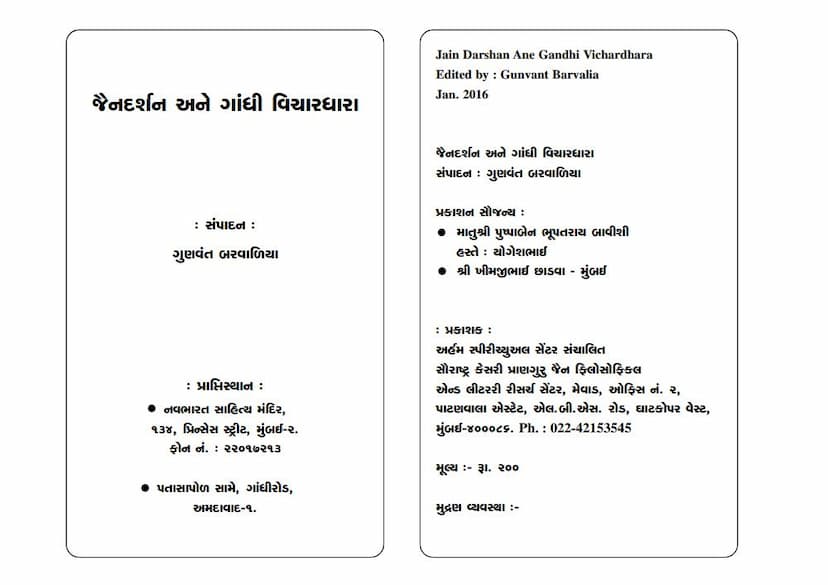Jain Darshan Ane Gandhi Vichardhara
Added to library: September 1, 2025

Summary
This document is a collection of essays titled "Jain Darshan Ane Gandhi Vichardhara" (Jain Philosophy and Gandhian Ideology), edited by Gunvant Barvalia and published by Arham Spiritual Centre. The book brings together various scholars who explore the profound connections and influences between Jain principles and the philosophy of Mahatma Gandhi.
Here's a summary of the key themes and points covered in the essays:
Overarching Theme:
The core of the book is to demonstrate how the fundamental tenets of Jainism, particularly its emphasis on Ahimsa (non-violence), Satya (truth), Aparigraha (non-possession), and Anekantavada (non-absolutism/multi-sidedness), deeply resonated with and shaped Mahatma Gandhi's worldview and actions. The essays highlight that while Gandhi may not have been a follower of Jainism in a strictly denominational sense, his life and philosophy were significantly influenced by Jain principles, often through his interactions with Jain thinkers like Shrimad Rajchandra.
Key Connections and Influences:
- Shrimad Rajchandra and Gandhi: Several essays focus on the pivotal relationship between Shrimad Rajchandra, a prominent Jain scholar and spiritual figure, and Mahatma Gandhi. Gandhi himself acknowledged Shrimad Rajchandra's profound impact on his spiritual development, viewing him as a significant guide. Shrimad's emphasis on Daya (compassion), his intellectual rigor, and his spiritual depth deeply influenced Gandhi's quest for truth and his ethical framework. Gandhi learned the concept of "Daya Dharma" from Shrimad, which guided his understanding of how to truly help others, even if it meant causing temporary discomfort for their ultimate good.
- Ahimsa (Non-violence): Jainism places Ahimsa at the absolute core of its philosophy, extending it to all living beings, from the smallest microorganisms to humans. The essays discuss how Gandhi adopted and adapted this principle, making it the cornerstone of his political and social activism. Gandhi's Ahimsa was not passive but active, a force for change and self-suffering to bring about justice and truth. The Jain concept of Ahimsa, encompassing mental, verbal, and physical non-violence, and its detailed classification (e.g., Sankalpi, Udyogi, Arambhi, Virodhi violence), is explored in relation to Gandhi's broader application of the principle in everyday life and political struggle.
- Satya (Truth): Both Jainism and Gandhi consider truth to be paramount. Gandhi famously stated, "Truth is God," and saw Ahimsa as the means to realize Truth. The essays highlight how Gandhi's life was a continuous experiment with Truth, and his unwavering commitment to it, even when facing immense opposition. Jainism's emphasis on speaking truth, even when it's difficult or unpopular, aligns with Gandhi's approach.
- Anekantavada (Non-absolutism): This core Jain principle, advocating that reality is viewed from multiple perspectives, greatly influenced Gandhi's ability to understand and engage with differing viewpoints. Gandhi's approach to conflict resolution and his willingness to listen to his opponents are seen as practical manifestations of Anekantavada. It allowed him to appreciate the multifaceted nature of truth and avoid rigid, dogmatic thinking.
- Aparigraha (Non-possession): The Jain ideal of minimizing possessions and attachments, even to one's own body, is mirrored in Gandhi's philosophy of simple living and his own practices. His concept of "Trusteeship," where wealth is held in trust for the benefit of society, draws parallels to the Jain ideal of detachment from material possessions. The essays discuss how Gandhi exemplified this by his own ascetic lifestyle, his advocacy for khadi, and his emphasis on living with minimal needs.
- Vow Observance (Vrata): The essays compare the Jain Pancha Mahavratas (five great vows) with Gandhi's eleven vows. Both systems emphasize self-discipline, ethical conduct, and spiritual growth through structured practices. The Jain commitment to vows like Brahmacharya (celibacy), Asteya (non-stealing), and Aparigraha is seen reflected in Gandhi's own emphasis on these principles for achieving personal and societal transformation.
- Other Jain Principles and Gandhi's Philosophy: The essays also touch upon the Jain concepts of Kshama (forgiveness), Abhaya (fearlessness), Shakahaar (vegetarianism), and the importance of Swadeshi (self-reliance), all of which found a strong echo in Gandhi's teachings and practices. Gandhi's respect for all religions and his promotion of interfaith dialogue are also linked to the Jain principle of Sarvadharma Samanvay (harmony of all religions).
- Inspiration for Social Reform: The essays highlight how Jain principles, particularly Ahimsa and the concept of a just social order, inspired Gandhi's work on social reform, including his efforts to eradicate untouchability and promote equality. The influence of Jain monks and their teachings on Gandhi's early life and mother is also mentioned.
- Vinoba Bhave and Muni Santbalji: The book also includes essays discussing the influence of Jainism on other prominent figures like Vinoba Bhave (a key disciple of Gandhi) and Muni Santbalji, another Jain monk who actively promoted Gandhian ideals in social reform, particularly in the Bhala-Nalkantha region. Vinoba's deep study of Jain texts and his appreciation for Jain philosophy are noted, as is Muni Santbalji's practical application of Gandhian principles within a Jain framework.
Overall Impact:
The collection aims to showcase the enduring relevance of Jain philosophy in shaping ethical and social thought, particularly through its influence on one of the 20th century's most influential figures, Mahatma Gandhi. It emphasizes that the universal and timeless principles found in Jainism provide a rich foundation for building a more just, compassionate, and peaceful world, echoing Gandhi's own vision. The book serves as a testament to the interconnectedness of spiritual and ethical traditions and their potential to inspire transformative action.